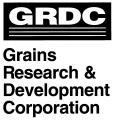epp
This project improved the preparedness of Australia's grain industry for incursions of Emergency Plant Pests (EPPs) by developing a national surveillance plan to support market access and provide contingency plans for threats to Australia's grains industry.
Research outcomes:
- Twenty two contingency plans for key high and medium priority pest threats to the Australian grains industry were prepared. These plans provide information on pest life cycles, potential distribution, survival strategies and methods for surveillance and sampling to assist with biosecurity preparedness.
- Audit of grain pest specific reference material held electronically by PHA was undertaken.
- Biosecurity awareness information was provided to researchers, growers, grains bulk handlers and agribusiness in the form of media articles and seminars.
- Development of surveillance plans for Russian wheat aphid, Hessian fly and Sunn pest to assist capture of data for both early detection of new pests and market access requirements.
Research implications:
The development or update of contingency plans for key pest threats and surveillance plans for Russian wheat aphid, Hessian fly and Sunn pest, together with the delivery of biosecurity messages, form an important part of biosecurity preparedness and prevention activities for the grains industry.
The development of contingency plans will provide information that will form the basis of response plans to pest incursions. The provision of information within the contingency plans will assist with more rapid eradication, containment or management mechanisms being put in place, helping both deliverers and beneficiaries of the emergency response.
Provision of awareness training and information is an important part of industry preparedness, assisting to increase the understanding of the importance of biosecurity and the response mechanisms Australia puts in place in the event of an incursion.
The surveillance plans for Russian wheat aphid, Hessian fly and Sunn pest provides a framework for a coordinated national approach to collection and capture of data for both early detection of new pests and market access requirements.
The surveillance plans assessed the probability of detection of each of these pests using routine crop monitoring. This framework has implications for all stakeholders in the grains supply chain that will be impacted by pests of market access concern or potential pest incursions.
Acknowledgements:
PHA wishes to acknowledge the CRC for National Plant Biosecurity (CRCNPB) and the Grains Research and Development Corporation (GRDC) for supporting this project.
PHA also acknowledges all experts who contributed to completion of contingency plans.
PROJECT LEADER

Dr Sharyn Taylor
Project Leader CRC30009: Grains Surveillance Strategy
staylor@phau.com.au
Phone: 02 6215 7700
Fax: 02 6260 4321
Read More
PROJECT DETAILS
Complete
Term
January 2006 – October 2008
Budget
$433,210 (cash and in-kind support)
PROGRAM DETAILS
LOCATION
CORE CRC PARTICIPANTS
Outcome
Response: Reduced losses from incursions by harmful pests and diseases.
Goal
Reduced economic and social impact from incursions of harmful pests and diseases through new control, risk mitigation and recovery strategies.
Indicators of success
Economic:
Decreased economic and social cost for future pest and disease eradications and scientific defensibility of market access conditions.
Science:
New tools to optimise incursion responses accepted by peers through scientific publication and invitations to present at key meetings, conferences and workshops.
Policy:
New tools to manage plant biosecurity threats are integrated into response strategies through consultation with end-users.
Impact/Adoption:
New procedures for the eradication of plant biosecurity threats are used by end-users.
Impact Management Research Projects
| Title | Leader |
| CRC40005: Rice Blast | Dr Ric Cother |
Rice blast, caused by Magnaporthe grisea, is generally considered the most important disease of rice worldwide because of its extensive distribution and destructiveness under favourable more | |
| CRC40006: Russian Wheat Aphid | Dr Owain Edwards |
This project will improve the level of preparedness for, and the sustainable resistance to, the Russian wheat aphid. it will also assist Australia's grain industry to remain free of Russian wheat more | |
| CRC40016: Pathogen Eradication Strategies | Dr Mark Sosnowski |
This project will provide alternative eradication strategies for emergency plant pest incursions on perennial crops. It will also reduce economic costs and social impact from emergency plant pest more | |
| CRC40024: Insect Eradication (phase one) | Mr Bill Woods |
Eradication of arthropod harmful plant pest incursions has often relied on destructive technologies such as crop removal and broad spectrum pesticide application. This strategy incurs a more | |
| CRC40035: Risk management processes for the movement of samples during an emergency plant pest (EPP) incursion | |
The objective of CRC40035 was to review the process of moving emergency plant pest (EPP) samples during incursion, determine critical control points to manage risks and make recommendations for more | |
| CRC40049: A community based model to manage emergency plant pests (phase one) | Prof Ian Falk |
This project will develop new policies and strategies to improve the management of emergency plant pest incursions. It will increase community and indigenous participation to identify, prevent and more | |
| CRC40050: Post Entry Quarantine (phase one) | Dr Brendan Rodoni |
This project developed advanced molecular diagnostic methods and immunological tools for the detection of plant viruses, which can be expediently applied in both post entry quarantine (PEQ) more | |
| CRC40088: Pre-harvest fruit fly | Dr Anthony Clarke |
The average gross value of Australian Horticulture over the past three years is estimated at over $7 billion per year. Most of this is not consumed close to the source, but is transported to more | |
| CRC40121: Biosecure packaging | Ms Barbara Hall |
Previously there were no guidelines for people to transport plant, soil and insect samples into and between laboratories. With the move to include harmful pests and diseases in the United more | |
| CRC40136: Insect Eradication (Phase two) | Mr Bill Woods |
As part of phase two of our Insect Eradication more | |
| CRC40139: Pathogen Eradication Strategies (Phase two) | Dr Mark Sosnowski |
As part of phase two of our Pathogen Eradication Strategies project, we developed more | |
| CRC40142: Airport Forensics | Ms Dominie Wright |
Airport Forensics was a joint project with Grains Research and Development Corporation (GRDC). This project defined the plant more | |
| CRC40180: SPHDS Ratification of Protocol for Potyviruses | Dr Brendan Rodoni |
The recently completed CRCNPB funded project (CRC40135) “Improved Post Entry Quarantine Diagnostics” has developed a diagnostic protocol to detect at least 40 known and unknown more | |
PROGRAM LEADER
Ms Jane Moran
Program Leader Impact Management
Email: j.moran@crcplantbiosecurity.com.au
Phone: 03 9210 9210
Fax: 03 9887 3609
Read More



